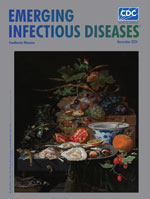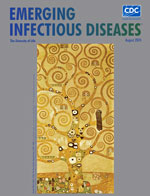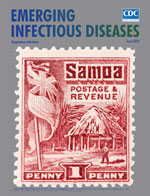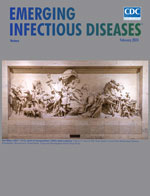Letters
Volume 31—2025
Volume 30—2024
Volume 29—2023
Volume 28—2022
Volume 27—2021
Volume 26—2020
Volume 25—2019
Volume 24—2018
Volume 23—2017
Volume 22—2016
Volume 21—2015
Volume 30—2024
Volume 29—2023
Volume 28—2022
Volume 27—2021
Volume 26—2020
Volume 25—2019
Volume 24—2018
Volume 23—2017
Volume 22—2016
Volume 21—2015
Volume 30—2024
Volume 30, Number 12—December 2024

Sporotrichosis in Domestic Cat and Zoonotic Transmission
| EID | More S, Snider TA, Ramachandran A. Sporotrichosis in Domestic Cat and Zoonotic Transmission. Emerg Infect Dis. 2024;30(12):2700-2701. https://doi.org/10.3201/eid3012.240864 |
|---|---|
| AMA | More S, Snider TA, Ramachandran A. Sporotrichosis in Domestic Cat and Zoonotic Transmission. Emerging Infectious Diseases. 2024;30(12):2700-2701. doi:10.3201/eid3012.240864. |
| APA | More, S., Snider, T. A., & Ramachandran, A. (2024). Sporotrichosis in Domestic Cat and Zoonotic Transmission. Emerging Infectious Diseases, 30(12), 2700-2701. https://doi.org/10.3201/eid3012.240864. |
Volume 30, Number 11—November 2024

Estimating Underdetection of Foodborne Disease Outbreaks
| EID | Hedberg CW, Firestone MJ, Kim TN, Edmundson AR, Bender JB. Estimating Underdetection of Foodborne Disease Outbreaks. Emerg Infect Dis. 2024;30(11):2451. https://doi.org/10.3201/eid3011.240198 |
|---|---|
| AMA | Hedberg CW, Firestone MJ, Kim TN, et al. Estimating Underdetection of Foodborne Disease Outbreaks. Emerging Infectious Diseases. 2024;30(11):2451. doi:10.3201/eid3011.240198. |
| APA | Hedberg, C. W., Firestone, M. J., Kim, T. N., Edmundson, A. R., & Bender, J. B. (2024). Estimating Underdetection of Foodborne Disease Outbreaks. Emerging Infectious Diseases, 30(11), 2451. https://doi.org/10.3201/eid3011.240198. |
Estimating Underdetection of Foodborne Disease Outbreaks (Response)
| EID | Ford L, Self JL, Wong KK, Hoekstra RM, Tauxe RV, Rose E, et al. Estimating Underdetection of Foodborne Disease Outbreaks (Response). Emerg Infect Dis. 2024;30(11):2452. https://doi.org/10.3201/eid3011.241351 |
|---|---|
| AMA | Ford L, Self JL, Wong KK, et al. Estimating Underdetection of Foodborne Disease Outbreaks (Response). Emerging Infectious Diseases. 2024;30(11):2452. doi:10.3201/eid3011.241351. |
| APA | Ford, L., Self, J. L., Wong, K. K., Hoekstra, R. M., Tauxe, R. V., Rose, E....Bruce, B. B. (2024). Estimating Underdetection of Foodborne Disease Outbreaks (Response). Emerging Infectious Diseases, 30(11), 2452. https://doi.org/10.3201/eid3011.241351. |
Volume 30, Number 8—August 2024

Transmission and Surveillance of Rat Hepatitis E Virus in Swine
| EID | Bezerra M, Oliveira da Paz M, de Oliveira-Filho E, de Souza Reis C. Transmission and Surveillance of Rat Hepatitis E Virus in Swine. Emerg Infect Dis. 2024;30(8):1739. https://doi.org/10.3201/eid3008.240484 |
|---|---|
| AMA | Bezerra M, Oliveira da Paz M, de Oliveira-Filho E, et al. Transmission and Surveillance of Rat Hepatitis E Virus in Swine. Emerging Infectious Diseases. 2024;30(8):1739. doi:10.3201/eid3008.240484. |
| APA | Bezerra, M., Oliveira da Paz, M., de Oliveira-Filho, E., & de Souza Reis, C. (2024). Transmission and Surveillance of Rat Hepatitis E Virus in Swine. Emerging Infectious Diseases, 30(8), 1739. https://doi.org/10.3201/eid3008.240484. |
Volume 30, Number 6—June 2024

Nontuberculous Mycobacteria and Laboratory Surveillance, Virginia, USA
| EID | See I, Jackson KA, Byram R, Toney N, Grigg C, Magill SS. Nontuberculous Mycobacteria and Laboratory Surveillance, Virginia, USA. Emerg Infect Dis. 2024;30(6):1302. https://doi.org/10.3201/eid3006.240431 |
|---|---|
| AMA | See I, Jackson KA, Byram R, et al. Nontuberculous Mycobacteria and Laboratory Surveillance, Virginia, USA. Emerging Infectious Diseases. 2024;30(6):1302. doi:10.3201/eid3006.240431. |
| APA | See, I., Jackson, K. A., Byram, R., Toney, N., Grigg, C., & Magill, S. S. (2024). Nontuberculous Mycobacteria and Laboratory Surveillance, Virginia, USA. Emerging Infectious Diseases, 30(6), 1302. https://doi.org/10.3201/eid3006.240431. |
Volume 30, Number 2—February 2024

No Evidence for Clade I Monkeypox Virus Circulation, Belgium
| EID | Liesenborghs L, Coppens J, Van Dijck C, Brosius I, De Baetselier I, Vercauteren K, et al. No Evidence for Clade I Monkeypox Virus Circulation, Belgium. Emerg Infect Dis. 2024;30(2):402. https://doi.org/10.3201/eid3002.231746 |
|---|---|
| AMA | Liesenborghs L, Coppens J, Van Dijck C, et al. No Evidence for Clade I Monkeypox Virus Circulation, Belgium. Emerging Infectious Diseases. 2024;30(2):402. doi:10.3201/eid3002.231746. |
| APA | Liesenborghs, L., Coppens, J., Van Dijck, C., Brosius, I., De Baetselier, I., Vercauteren, K....Van Esbroeck, M. (2024). No Evidence for Clade I Monkeypox Virus Circulation, Belgium. Emerging Infectious Diseases, 30(2), 402. https://doi.org/10.3201/eid3002.231746. |
Nonnegligible Seroprevalence and Predictors of Murine Typhus, Japan
| EID | Iwata K. Nonnegligible Seroprevalence and Predictors of Murine Typhus, Japan. Emerg Infect Dis. 2024;30(2):403. https://doi.org/10.3201/eid3002.230827 |
|---|---|
| AMA | Iwata K. Nonnegligible Seroprevalence and Predictors of Murine Typhus, Japan. Emerging Infectious Diseases. 2024;30(2):403. doi:10.3201/eid3002.230827. |
| APA | Iwata, K. (2024). Nonnegligible Seroprevalence and Predictors of Murine Typhus, Japan. Emerging Infectious Diseases, 30(2), 403. https://doi.org/10.3201/eid3002.230827. |
Nonnegligible Seroprevalence and Predictors of Murine Typhus, Japan (Response)
| EID | Aita T, Sando E, Katoh S, Hamaguchi S, Fujita H, Kurita N. Nonnegligible Seroprevalence and Predictors of Murine Typhus, Japan (Response). Emerg Infect Dis. 2024;30(2):403-404. https://doi.org/10.3201/eid3002.231465 |
|---|---|
| AMA | Aita T, Sando E, Katoh S, et al. Nonnegligible Seroprevalence and Predictors of Murine Typhus, Japan (Response). Emerging Infectious Diseases. 2024;30(2):403-404. doi:10.3201/eid3002.231465. |
| APA | Aita, T., Sando, E., Katoh, S., Hamaguchi, S., Fujita, H., & Kurita, N. (2024). Nonnegligible Seroprevalence and Predictors of Murine Typhus, Japan (Response). Emerging Infectious Diseases, 30(2), 403-404. https://doi.org/10.3201/eid3002.231465. |
Volume 30, Number 1—January 2024

Use of Zoo Mice in Study of Lymphocytic Choriomeningitis Mammarenavirus, Germany
| EID | de Bellocq J, Baird S, Fornůsková A. Use of Zoo Mice in Study of Lymphocytic Choriomeningitis Mammarenavirus, Germany. Emerg Infect Dis. 2024;30(1):205. https://doi.org/10.3201/eid3001.230334 |
|---|---|
| AMA | de Bellocq J, Baird S, Fornůsková A. Use of Zoo Mice in Study of Lymphocytic Choriomeningitis Mammarenavirus, Germany. Emerging Infectious Diseases. 2024;30(1):205. doi:10.3201/eid3001.230334. |
| APA | de Bellocq, J., Baird, S., & Fornůsková, A. (2024). Use of Zoo Mice in Study of Lymphocytic Choriomeningitis Mammarenavirus, Germany. Emerging Infectious Diseases, 30(1), 205. https://doi.org/10.3201/eid3001.230334. |
Use of Zoo Mice in Study of Lymphocytic Choriomeningitis Mammarenavirus, Germany (Response)
| EID | Mehl C, Wylezich C, Geiger C, Schauerte N, Mätz-Rensing K, Nesseler A, et al. Use of Zoo Mice in Study of Lymphocytic Choriomeningitis Mammarenavirus, Germany (Response). Emerg Infect Dis. 2024;30(1):205-206. https://doi.org/10.3201/eid3001.231521 |
|---|---|
| AMA | Mehl C, Wylezich C, Geiger C, et al. Use of Zoo Mice in Study of Lymphocytic Choriomeningitis Mammarenavirus, Germany (Response). Emerging Infectious Diseases. 2024;30(1):205-206. doi:10.3201/eid3001.231521. |
| APA | Mehl, C., Wylezich, C., Geiger, C., Schauerte, N., Mätz-Rensing, K., Nesseler, A....Ulrich, R. G. (2024). Use of Zoo Mice in Study of Lymphocytic Choriomeningitis Mammarenavirus, Germany (Response). Emerging Infectious Diseases, 30(1), 205-206. https://doi.org/10.3201/eid3001.231521. |
SARS-CoV-2 Incubation Period during Omicron BA.5–Dominant Period, Japan
| EID | Cheng H, Akhmetzhanov AR, Dushoff J. SARS-CoV-2 Incubation Period during Omicron BA.5–Dominant Period, Japan. Emerg Infect Dis. 2024;30(1):206-207. https://doi.org/10.3201/eid3001.230208 |
|---|---|
| AMA | Cheng H, Akhmetzhanov AR, Dushoff J. SARS-CoV-2 Incubation Period during Omicron BA.5–Dominant Period, Japan. Emerging Infectious Diseases. 2024;30(1):206-207. doi:10.3201/eid3001.230208. |
| APA | Cheng, H., Akhmetzhanov, A. R., & Dushoff, J. (2024). SARS-CoV-2 Incubation Period during Omicron BA.5–Dominant Period, Japan. Emerging Infectious Diseases, 30(1), 206-207. https://doi.org/10.3201/eid3001.230208. |
SARS-CoV-2 Incubation Period during Omicron BA.5–Dominant Period, Japan (Response)
| EID | Ogata T, Tanaka H. SARS-CoV-2 Incubation Period during Omicron BA.5–Dominant Period, Japan (Response). Emerg Infect Dis. 2024;30(1):207. https://doi.org/10.3201/eid3001.231487 |
|---|---|
| AMA | Ogata T, Tanaka H. SARS-CoV-2 Incubation Period during Omicron BA.5–Dominant Period, Japan (Response). Emerging Infectious Diseases. 2024;30(1):207. doi:10.3201/eid3001.231487. |
| APA | Ogata, T., & Tanaka, H. (2024). SARS-CoV-2 Incubation Period during Omicron BA.5–Dominant Period, Japan (Response). Emerging Infectious Diseases, 30(1), 207. https://doi.org/10.3201/eid3001.231487. |
Page created: November 07, 2023
Page updated: November 26, 2024
The conclusions, findings, and opinions expressed by authors contributing to this journal do not necessarily reflect the official position of the U.S. Department of Health and Human Services, the Public Health Service, the Centers for Disease Control and Prevention, or the authors' affiliated institutions. Use of trade names is for identification only and does not imply endorsement by any of the groups named above.




